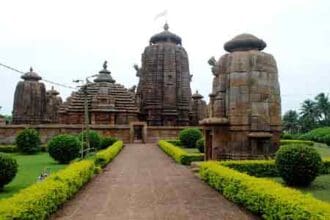Nestled on the banks of the mighty Ganges River, Bhagalpur , often referred to as the “Silk City of India,” is a treasure trove of history, culture, and natural beauty. Located in the eastern state of Bihar, this ancient city has been a significant hub since the days of the Mauryan Empire. From its rich silk heritage to serene temples and lush green landscapes, Bhagalpur offers a diverse range of attractions that cater to history buffs, nature lovers, and spiritual seekers alike.
In this article, we’ll explore the top 5 places to see in Bhagalpur , each offering a unique glimpse into the region’s vibrant past and present. Whether you’re marveling at ancient ruins, exploring wildlife sanctuaries, or soaking in the tranquility of sacred sites, Bhagalpur promises an unforgettable experience.
1. Vikramshila Gangetic Dolphin Sanctuary
A Haven for Endangered Wildlife
The Vikramshila Gangetic Dolphin Sanctuary is one of Bhagalpur’s most iconic attractions and a must-visit for wildlife enthusiasts. Spanning approximately 60 kilometers along the Ganges River, it is the only sanctuary in India dedicated to the conservation of the endangered Gangetic river dolphin, locally known as “Susu.”
- Why It Matters: The Gangetic dolphin is a critically endangered species, with fewer than 2,000 individuals left in the wild. This sanctuary plays a vital role in protecting these gentle creatures and their aquatic habitat.
- Activities: Visitors can take boat rides along the river to spot dolphins in their natural environment. Early mornings and late afternoons are the best times for sightings, as the dolphins are more active during these hours.
- Boat Safaris: Local operators offer guided boat safaris, providing insights into the ecosystem and the challenges faced by these majestic mammals. These tours typically last between 1 to 2 hours, depending on the operator.
- Birdwatching: The sanctuary is also home to a variety of migratory and resident bird species, making it a paradise for birdwatchers. Species like kingfishers, herons, and egrets are commonly spotted along the riverbanks.
- Conservation Efforts: The sanctuary works closely with local communities and environmental organizations to promote sustainable practices and raise awareness about the importance of conserving the Ganges River and its biodiversity. Initiatives include river clean-up drives, educational programs, and research projects aimed at understanding dolphin behavior.
- Tips for Visitors: Bring binoculars for better dolphin viewing, wear sunscreen, and carry water bottles. Respect the rules to minimize disturbance to the animals. Avoid loud noises and sudden movements that could scare the dolphins away.
2. Mandar Hill
A Mythological Marvel
Mandar Hill, located about 30 kilometers from Bhagalpur, holds immense religious significance and is steeped in Hindu mythology. According to legend, this hill was used by Lord Vishnu as a churning rod during the Samudra Manthan (churning of the ocean).
- Historical Significance: Archaeological findings suggest that Mandar Hill was once a major center of Buddhist learning, with ruins of ancient stupas and monasteries still visible today. Scholars believe it served as a hub for monks and scholars during the Mauryan and Gupta periods.
- Key Attractions:
- Buddha Statue: At the base of the hill stands a massive statue of Lord Buddha, symbolizing peace and enlightenment. This statue is a popular spot for meditation and photography.
- Ancient Temples: Several temples dot the hill, including the Shiva Temple, which attracts pilgrims throughout the year. These temples feature intricate carvings and sculptures that reflect the artistic excellence of ancient craftsmen.
- Natural Beauty: The hill is surrounded by dense forests and offers panoramic views of the surrounding plains, making it a popular spot for picnics and hikes. During winter, the cool breeze and misty mornings add to the charm of the place.
- Trekking Experience: A moderate trek to the top of the hill rewards visitors with breathtaking vistas and a sense of accomplishment. The trail passes through scenic landscapes and ancient ruins, offering glimpses of both nature and history.
- Photography Opportunities: Capture the intricate carvings on temple walls, the serene Buddha statue, and the lush greenery surrounding the hill. Sunrise and sunset are particularly magical times for photography, with soft light casting a golden glow over the landscape.
3. Agam Kuan
An Ancient Engineering Marvel
Agam Kuan, or the “Unfathomable Well,” is one of the oldest and most mysterious structures in Bhagalpur. Built during the reign of Emperor Ashoka, this well is believed to have served both utilitarian and spiritual purposes.
- Architectural Features: The well consists of eight arched windows at the top, leading down to a deep cylindrical shaft. Its design reflects advanced engineering skills of the Mauryan era, showcasing the ingenuity of ancient builders.
- Mythological Legends: According to folklore, Agam Kuan was used for rituals and sacrifices during Ashoka’s early years before he embraced Buddhism. Some legends even link it to supernatural occurrences, adding an air of mystery to the site.
- Surrounding Area: The site is located near the ruins of an ancient palace, adding to its historical allure. Visitors can explore the remnants of this once-grand structure while imagining life in ancient Bhagalpur. Fragments of pillars, walls, and foundations provide clues about the architectural style of the period.
- Visitor Guidelines: Entry to the site is free, but guided tours are recommended for those interested in learning about its history and significance. Knowledgeable guides share fascinating stories and insights that bring the site to life.
4. Bhagalpur College of Engineering Museum
A Journey Through Time
For those fascinated by science and technology, the Bhagalpur College of Engineering Museum offers a unique opportunity to explore the evolution of engineering and innovation over the centuries.
- Exhibits: The museum houses a collection of vintage machinery, tools, and models used in various fields of engineering. Highlights include steam engines, textile looms, and agricultural equipment. Each exhibit is accompanied by detailed descriptions explaining its function and historical context.
- Educational Value: Interactive displays and demonstrations provide insights into how these technologies shaped industries and improved lives. School groups often visit the museum as part of educational tours, allowing students to connect classroom learning with real-world applications.
- Local Connection: Many exhibits highlight Bhagalpur’s contributions to India’s industrial growth, particularly in the silk and textile sectors. For instance, traditional handlooms and spinning wheels showcase the craftsmanship that made Bhagalpur famous for its silk production.
- Tips for Visitors: Allocate at least an hour to fully appreciate the museum’s offerings. Photography is allowed, so bring your camera to capture interesting artifacts. If possible, visit during weekdays when the museum is less crowded.
5. Nathnagar Ashram
A Spiritual Retreat
Nathnagar Ashram, located on the outskirts of Bhagalpur, is a serene spiritual retreat that attracts devotees and tourists seeking peace and introspection. Founded by Swami Satyananda Saraswati, this ashram is a center for yoga, meditation, and holistic living.
- Key Features:
- Temples and Shrines: The ashram complex includes several temples dedicated to deities like Hanuman, Durga, and Shiva. These shrines exude a divine aura and are ideal for prayer and reflection. The main temple features elaborate carvings and vibrant murals depicting scenes from Hindu epics.
- yoga and meditation Programs: Regular classes and workshops are conducted for visitors interested in learning yoga and meditation techniques. These programs are suitable for all skill levels, from beginners to advanced practitioners. Sessions focus on physical postures, breathing exercises, and mindfulness practices.
- Natural Surroundings: The ashram is surrounded by lush gardens and tranquil ponds, creating a soothing environment conducive to relaxation. Walking paths wind through the property, inviting visitors to connect with nature.
- Cultural Events: During festivals like Navratri and Diwali, the ashram hosts special events featuring devotional music, discourses, and community feasts. These celebrations offer a glimpse into the cultural and spiritual traditions of the region.
- Accommodation Options: Basic lodging facilities are available for those who wish to stay overnight. Rooms are simple yet comfortable, equipped with essential amenities. Advance booking is recommended, especially during peak seasons and festival times.
Travel Tips for Visiting Bhagalpur
If you’re planning a trip to Bhagalpur, here are some essential tips to enhance your experience:
- Best Time to Visit: October to March is the ideal time to visit, as the weather is pleasant and suitable for outdoor activities. Summers (April to June) can be extremely hot, while monsoons bring heavy rainfall.
- How to Reach Bhagalpur:
- By Air: The nearest airport is Patna Airport, approximately 240 kilometers away. From there, you can hire a taxi or take a train to Bhagalpur.
- By Train: Bhagalpur Railway Station is well-connected to major cities like Delhi, Kolkata, and Mumbai. Trains are frequent and affordable, making rail travel a convenient option.
- By Road: State-run buses and private taxis operate regular services to Bhagalpur from nearby towns and cities. Self-driving is another option, allowing flexibility in exploring remote areas.
- Local Cuisine: Don’t miss out on traditional Bihari dishes such as litti-chokha, sattu paratha, and malpua. Street food stalls and local eateries serve authentic flavors at affordable prices. Try the famous “Khaja,” a sweet delicacy made from layers of flour and sugar syrup.
- Shopping: Bhagalpur is famous for its silk products, including sarees, scarves, and stoles. Visit local markets like Sabzi Mandi and Silk Market to purchase high-quality silk items. Bargaining is common, so don’t hesitate to negotiate for better prices.
- Safety Precautions: While Bhagalpur is generally safe for tourists, always exercise caution and avoid venturing into isolated areas after dark. Keep valuables secure and carry copies of important documents.
- Respect Local Customs: Familiarize yourself with local traditions and dress modestly when visiting religious sites. Remove shoes before entering temples and ashrams, and seek permission before taking photographs of people.
- Eco-Friendly Practices: Support sustainable tourism by minimizing waste, using reusable water bottles, and respecting the natural environment. Dispose of trash responsibly and participate in eco-friendly initiatives whenever possible.
- Emergency Contacts: Keep emergency numbers handy, including those of local hospitals, police stations, and tour operators. Share your itinerary with friends or family members to ensure someone knows your whereabouts.
- Language: Hindi is the primary language spoken in Bhagalpur, but English is understood in tourist areas and hotels. Learning a few basic Hindi phrases can help you communicate more effectively with locals.
- Currency Exchange: ATMs and banks are available in Bhagalpur for currency exchange and cash withdrawals. Carry sufficient cash if traveling to rural areas, as card acceptance may be limited.
Conclusion
Bhagalpur is a city where history, spirituality, and nature converge to create a truly enriching travel experience. From the enchanting Vikramshila Gangetic Dolphin Sanctuary to the mystical Mandar Hill , each destination tells a unique story of the region’s rich heritage and natural beauty. Whether you’re exploring ancient ruins, immersing yourself in spiritual practices, or indulging in the city’s famed silk culture, Bhagalpur promises memories that will last a lifetime.
Plan your visit today and let the charm of Bhagalpur captivate your heart!
10 Frequently Asked Questions (FAQs)
- What is Bhagalpur famous for?
- Bhagalpur is renowned for its silk production, earning it the title of “Silk City of India.” It is also known for its historical sites and natural attractions.
- How far is Bhagalpur from Patna?
- Bhagalpur is approximately 240 kilometers from Patna, the capital of Bihar.
- Are there any entry fees for tourist spots in Bhagalpur?
- Most attractions, like Mandar Hill and Agam Kuan, have no entry fees. However, some places may charge nominal amounts for guided tours.
- Is Bhagalpur safe for solo travelers?
- Yes, Bhagalpur is generally safe for solo travelers. Always take standard precautions and inform someone about your plans.
- Can I buy silk products directly from weavers in Bhagalpur?
- Yes, many silk weavers sell their products directly to customers. Visiting weaving clusters like Adityapur provides an authentic experience.
- What is the best way to explore Bhagalpur?
- Hiring a private vehicle or taxi is the most convenient way to explore Bhagalpur and its surrounding attractions.
- Are vegetarian food options available in Bhagalpur?
- Yes, most restaurants and eateries offer vegetarian options, including traditional Bihari dishes.
- What should I pack for my trip to Bhagalpur?
- Pack comfortable clothing, sunscreen, insect repellent, and sturdy shoes for sightseeing. Carry a reusable water bottle to stay hydrated.
- Can I visit all these places in one day?
- It’s not advisable to cover all attractions in one day due to travel distances and time constraints. Plan your itinerary over 2-3 days for a relaxed experience.
- Are pets allowed at tourist spots in Bhagalpur?
- Pets are generally not allowed inside sanctuaries and protected areas. Check specific rules before bringing pets along.











